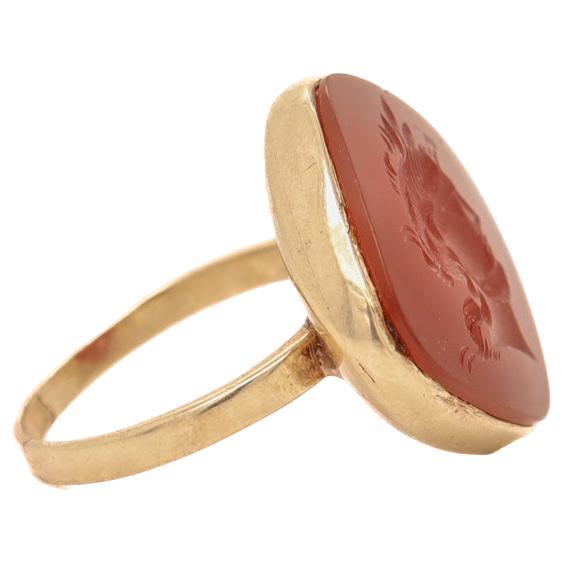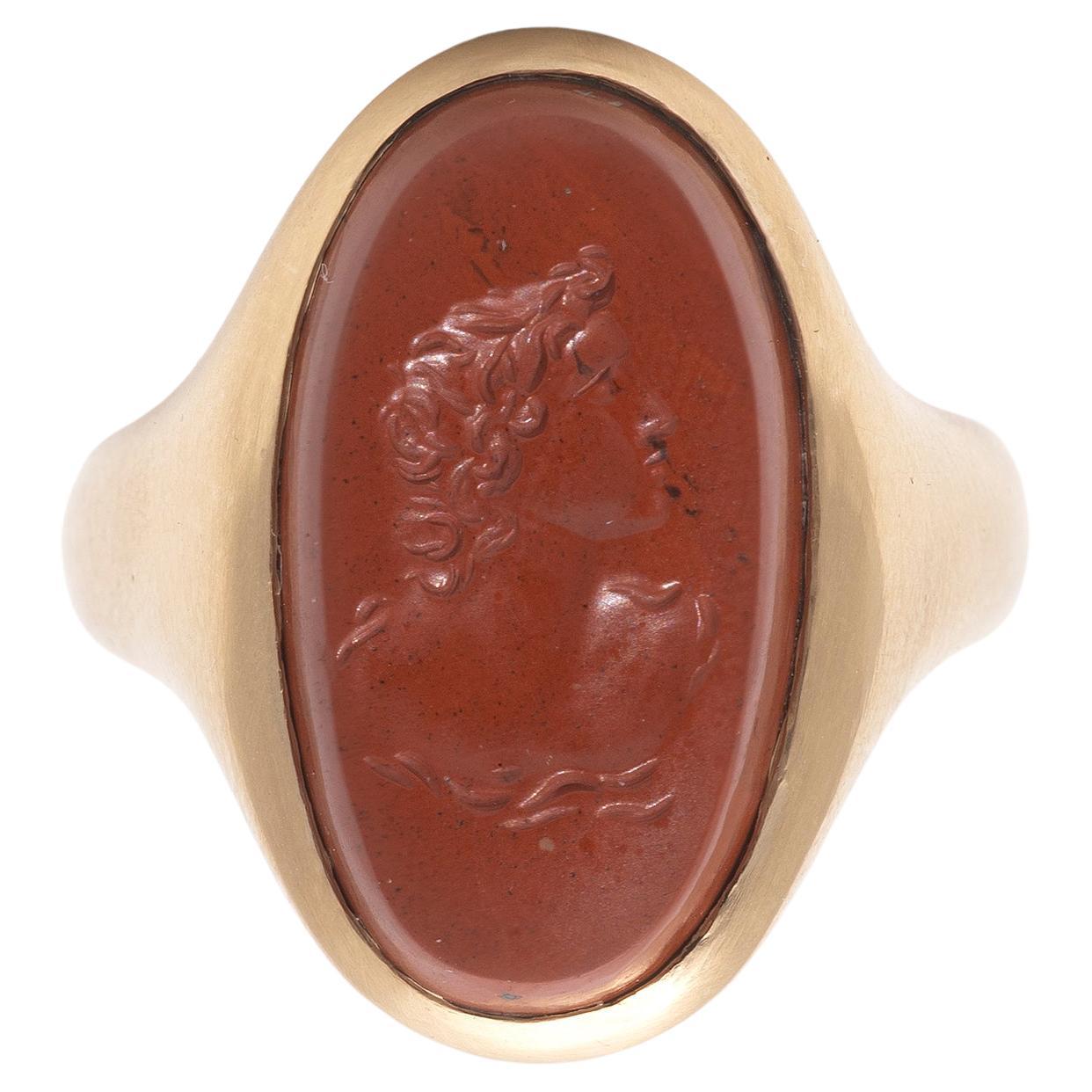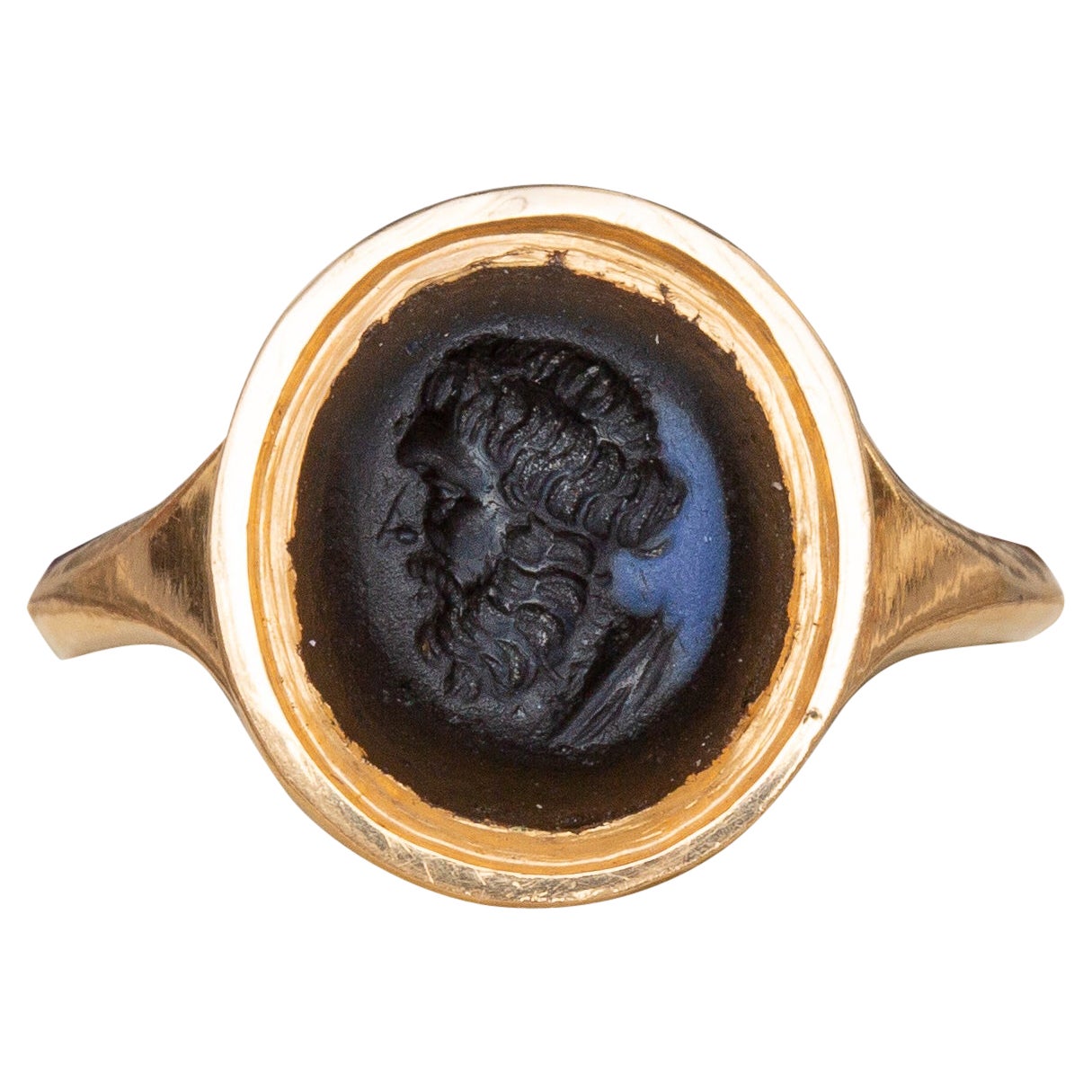Items Similar to Ancient Roman Carved Red Jasper Gryllus Signet Ring Antique Georgian
Want more images or videos?
Request additional images or videos from the seller
1 of 12
Ancient Roman Carved Red Jasper Gryllus Signet Ring Antique Georgian
About the Item
An ancient Romano-British carved jasper intaglio dating from the 2nd to 3rd century AD, set in a later gold mount dating from the late 18th century. The intaglio is intricately carved from a red jasper gemstone to depict a ‘gryllus’. The term ‘gryllus’ is often applied to intaglios with unusual combinations of human heads and animal parts. Derived from the Italic word grillo ("freak") and the Latin gryllus ("caricature"), they were popular subjects for carved gems in Roman times. While undoubtedly extremely amusing to the ancient Romans, these gems served a more serious purpose as well; they were thought to to have apotropaic or prophylactic properties. These creatures were known for their protective and guardian qualities. This one is possibly a fragment from a larger carving and features two heads at right angles to each other, one of them depicts Silenus with the ears of a dog or pig.
Glyptics or gem carvings have been admired since the start of the Roman Empire. This fascination has been revived throughout history, notably in the Renaissance period, and again during the Georgian and Victorian eras where many ancient cameos and intaglios were collected by young, aristocratic gentlemen during their ‘Grand Tour’ which led to the formation of significant collections. Like our example, many of these intaglios were set into jewellery, particularly in the late 18th and early 19th century; Message for an image of other similar examples in the British Museum (museum no. : 1799,0521.30, 1814,0704.1457, 1814,0704.1360).
The carved stone is set in a classic rubover setting with a grooved bezel, flared shoulders and plain tapering band, typical of the period. The ring is unmarked but tests as crafted in 21K gold and has a fantastic smooth silk-like texture commensurate with its impressive age.
UK size J, US size 4.75, intaglio measures 8mm x 7mm
Silenus was a companion to the wine god Dionysus, and suitably he was a notorious consumer of wine, usually drunk and supported by satyrs or carried by a donkey. Silenus was described as the oldest, wisest and most drunken of the followers of Dionysus, and was said to possess special knowledge and the power of prophecy when intoxicated. He presides over the other satyrs and is related to musical creativity, prophetic ecstasy, drunken joy and drunken dances.
- Ring Size:4.75 US, Resizable
- Stone:
- Stone Cut:
- Style:
- Place of Origin:
- Period:
- Date of Manufacture:200
- Condition:Wear consistent with age and use.
- Seller Location:London, GB
- Reference Number:1stDibs: LU2845222110282
Resizing is available.
About the Seller
5.0
Vetted Seller
These experienced sellers undergo a comprehensive evaluation by our team of in-house experts.
Established in 2019
1stDibs seller since 2022
32 sales on 1stDibs
Typical response time: 11 hours
- ShippingRetrieving quote...Ships From: London, United Kingdom
- Return PolicyA return for this item may be initiated within 14 days of delivery.
More From This SellerView All
- Georgian 18th Century Signet Ring with Ancient Roman Nicolo Intaglio of HerculesLocated in London, GBA superb ancient Roman nicolo intaglio set in a late 18th century gold signet ring. Nicolo intaglios are a particular type of intaglio ma...Category
Antique Late 18th Century English Georgian Signet Rings
- Georgian Gold and Carnelian Signet Ring Large 19th Century Antique Seal RingLocated in London, GBA large antique English Georgian era gentleman’s gold signet ring, circa 1830. In the centre there is a flat-cut and bezel-set octagonal carneli...Category
Antique Early 19th Century British Georgian Signet Rings
MaterialsCarnelian, Gold
- Antique Georgian Noble Irish 'Cole' Family Coat of Arms Signet Ring Earl's RingLocated in London, GBA large, heavy gold Irish noble signet ring, set with a carnelian intaglio depicting the coat of arms of the aristocratic Cole family. The stone would have originally been set into a...Category
Antique Early 19th Century English Georgian Signet Rings
MaterialsCarnelian, 14k Gold
- Ancient Roman Green Chalcedony Plasma Intaglio Ring of Goddess Victoria NikeLocated in London, GBA scarce ancient Roman intaglio dating from the 1st to 2nd century AD, depicting Victoria, the Roman Goddess of Victory (also known as Nike in Greek mythology). The cabochon gemstone is a chromium chalcedony, mottled green in colour. It was known in the ancient world as a ‘plasma’ stone and was widely used in jewellery and seals throughout the Roman Empire. However the mineral disappeared from use in the ancient world towards the end of the 2nd century AD when the known deposits were mined out. The intricate ancient engraving depicts a winged Victoria, draped and facing left, holding a palm branch in her right hand and a laurel leaf in her left. The green gem is translucent and contains small dotted black natural inclusions. The gemstone’s viridian green tones were linked to nature, growth, and prosperity, reflecting the Romans' appreciation for abundance and fertility. Victoria played a major part of Roman society, with many temples erected in her honour including one on the Palatine Hill which would house the spoils of war from Roman victories. She was, to the Romans, a symbol of victory over death, ultimately determining who would be successful during war. The high number of artistic and architectural dedications to her bear witness to the popularity of the goddess’ cult: Victoria widely appears on Roman coins...Category
Antique 15th Century and Earlier Italian Classical Roman Signet Rings
MaterialsChalcedony, 22k Gold
- Small Ancient Indus Valley Bead Ring Etched Carnelian Cone Antique Gold RingLocated in London, GBA superb and rare ancient Indus Valley etched carnelian bead ring. The conical shaped carnelian gemstone in the centre dates from the middle of the third millennium BC. Deep orange in colour with white patterned etchings, these beads originate from the Indus Valley civilisation (parts of modern day Pakistan and India). These carnelian beads were alkaline-bleached to develop the geometric white patterns visible on the exterior. The technique was first developed by the Harappans of the Indus Valley civilisation, and vast quantities have been found in archaeological sites all across the Indus Valley. The conical stone has been set in a later high-karat gold ring mount, the hoop is hollow and of circular cross section which widens towards the bezel. This design and shape is typical of ancient gold rings...Category
Antique 18th Century Indian Signet Rings
MaterialsCarnelian, Gold
- Rare Ancient Egyptian Carved Carnelian Frog Amulet Swivel Ring 18th DynastyLocated in London, GBThis rare Egyptian carved carnelian frog amulet dates to the Eighteenth Dynasty of the New Kingdom, circa 1300 BC. Frog amulets, depicting the goddess Heket, were commonly worn by both the living as a fertility charm and the dead to provide rejuvenation and a long afterlife. The ancient amulet is pierced horizontally and set into a later gold swivel mount, probably dating from the late 19th century. The design of the gold mount inspired by rings worn by the ancient Egyptians and Etruscans with its swivel bezel and coiled wire on the shoulders. The immense number of offspring made the frog an important symbol of fertility in ancient Egypt, and carved frog amulets were worn by women hoping for an easy delivery. This is exemplified with the goddess and protector of birth, Keket, who was depicted as a frog. After death, frog amulets would be placed within the wrappings of mummies, both men and women, in hope of a successful rebirth in the afterlife. The association between this amphibian and rebirth may have been induced by the fact that every year, millions of frogs spontaneously appeared out of the river mud and filled the fields after the annual inundation of the Nile. This caused the Egyptians to believe that they spontaneously generated themselves out of the river mud. The influence of frogs in Ancient Egypt can be seen in the language, the hieroglyphic sign for "one hundred thousand" was a tadpole, and one of the Egyptian terms denoting "frogs" is whm-anx, meaning literally "they who repeat life." Similar examples of ancient Egyptian carved...Category
Antique 15th Century and Earlier Signet Rings
MaterialsCarnelian, 22k Gold
You May Also Like
- Antique Gold & Carved Carnelian Intaglio Signet Ring with an Ancient Roman HeroLocated in Philadelphia, PAA fine antique intaglio ring. Likely converted from an antique button or pin. In 14k gold With a carved carnelian cabochon depicting an unidentified Roman hero. Marked 14k to the...Category
20th Century Etruscan Revival Signet Rings
MaterialsCarnelian, Gold
- Ancient Roman First Century AD Red Jasper Intaglio of Apollo Men's RingLocated in Firenze, ITAncient Roman first century AD red jasper intaglio of Apollo in later 18kt carat yellow gold. Size 8 Long 2,3cm Weight:14,92gr.Category
Antique 15th Century and Earlier Italian Classical Roman Signet Rings
MaterialsJasper, 18k Gold, Yellow Gold
- Ancient Roman Coin & Sterling Silver Signet RingLocated in Philadelphia, PAA very fine Roman coin signet ring. With an ancient Constantine I The Great bronze coin bezel set in a sterling silver signet ring setting. Signed '...Category
20th Century Unknown Classical Roman Signet Rings
MaterialsSterling Silver
- Ancient Roman Bronze Carved Signet Ring with 22 Karat Gold BezelBy Vicki OrrLocated in Naples, FLAuthentic ancient Roman carved bronze signet ring (1st-4th century AD) with newly added 22k yellow gold bezel. Ring measures approximately size 7....Category
Antique 15th Century and Earlier American Contemporary Signet Rings
MaterialsGold, 22k Gold, Yellow Gold, Bronze
- Ancient Roman Bronze Carved Signet Ring with 22 Karat Gold Rope BezelBy Vicki OrrLocated in Naples, FLAuthentic ancient Roman carved bronze signet ring (1st-4th century AD) with newly added 22k yellow gold rope detail bezel. Ring measures approxima...Category
Antique 15th Century and Earlier American Contemporary Signet Rings
MaterialsGold, 22k Gold, Yellow Gold, Bronze
- Ancient Roman Bronze Carved Signet Ring with 22 Karat Gold Rope BezelBy Vicki OrrLocated in Naples, FLAuthentic ancient Roman carved bronze signet ring (1st-4th century AD) with newly added 22k yellow gold rope detail bezel. Ring measures approxima...Category
Antique 15th Century and Earlier American Classical Roman Signet Rings
MaterialsGold, 22k Gold, Yellow Gold, Bronze





